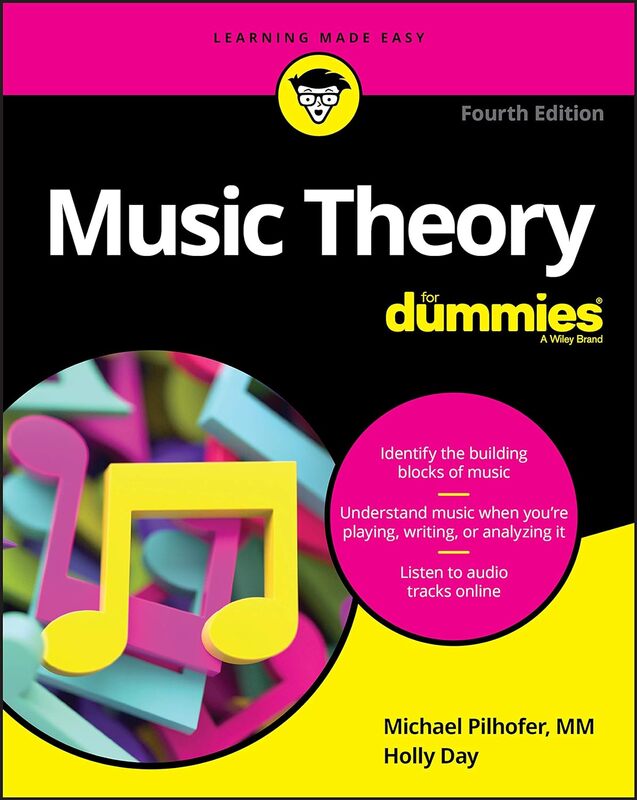پس از انتخاب نوع چاپ با کلیک بر روی کلمه "اضافه به سبد خرید" کتاب های خود را به راحتی خرید نمایید

خرید کتاب تئوری موسیقی Music Theory For Dummies
۳۴۰٫۰۰۰
۳۵۵٫۰۰۰۳۴۰٫۰۰۰۳۵۵٫۰۰۰
خرید کتاب تئوری موسیقی Music Theory For Dummies
- نویسنده: Michael Pilhofer , Holly Day
- ناشر: انتشارات McGraw Hill
- سال چاپ: 2024
- تعداد جلد: 1
- زبان کتاب: انگلیسی
- شابک 9781119575528
- نوع جلد:شومیز
- قطع وزیری
- صفحات کتاب سیاه سفید
- تعداد صفحات 336
با نحوه کار موسیقی واقعاً هماهنگ شوید
چه یک دانشآموز، یک مجری یا صرفاً یک طرفدار، این کتاب تئوری موسیقی را آسان میکند و راهنمای دوستانهای برای مفاهیم، هنر و تسلط فنی که زیربنای تولید موسیقی عالی است را در اختیار شما قرار میدهد. شما به سرعت در اصول اولیه حذف ضربها، خواندن نمرات و پیشبینی اینکه یک قطعه باید به کجا برسد، مسلط میشوید، به شما دیدگاه عمیقتری نسبت به آثار دیگران میدهد - و بعد دیگری را برای خودتان به ارمغان میآورد.
با دنبال کردن یک دوره معمولی در سطح کالج، «تئوری موسیقی برای آدمکها» مفاهیم دشوار را به بخشهای قابل مدیریت تقسیم میکند و همه جنبههای تولید و قدردانی موسیقی را در نظر میگیرد - از اصول نتها و مقیاسها گرفته تا پیچیدگیهای بیان و رنگ صدای ساز. همچنین آخرین تکنیکهای آموزشی را بررسی میکند - زیرا مطالعه موسیقی، که اکنون نشان داده شده است که مزایای شناختی و یادگیری را هم برای کودکان و هم برای بزرگسالان فراهم میکند، در همه سطوح رایجتر میشود.
بر مقیاسهای اصلی و فرعی، فواصل، زمینها و کلیدها مسلط شوید
نمادهای اولیه، سیگنال های زمان، سرعت، دینامیک و ناوبری را درک کنید
از ملودی ها، آکوردها، پیشرفت ها و عبارات برای ایجاد موسیقی استفاده کنید
هارمونی و ملودی های همراه برای صدا و سازها بسازید
به هر کجا که می خواهید از نظر موسیقی بروید - به عنوان یک نویسنده یا مجری، یا فقط به عنوان کسی که می خواهد از موسیقی نهایت لذت را ببرد - این راهنمای قابل دسترس هر آنچه را که باید بشنوید در اختیار شما قرار می دهد!
Tune in to how music really works
Whether you’re a student, a performer, or simply a fan, this book makes music theory easy, providing you with a friendly guide to the concepts, artistry, and technical mastery that underlie the production of great music. You’ll quickly become fluent in the fundamentals of knocking out beats, reading scores, and anticipating where a piece should go, giving you a deeper perspective on the works of others ― and bringing an extra dimension to your own.
Tracking to a typical college-level course, Music Theory For Dummies breaks difficult concepts down to manageable chunks and takes into account every aspect of musical production and appreciation ― from the fundamentals of notes and scales to the complexities of expression and instrument tone color. It also examines the latest teaching techniques ― all the more important as the study of music, now shown to provide cognitive and learning benefits for both children and adults, becomes more prevalent at all levels.
Master major and minor scales, intervals, pitches, and clefs
Understand basic notation, time signals, tempo, dynamics, and navigation
Employ melodies, chords, progressions, and phrases to form music
Compose harmonies and accompanying melodies for voice and instruments
Wherever you want to go musically ― as a writer or performer, or just as someone who wants to enjoy music to its fullest ― this approachable guide gives you everything you need to hear!
دیدگاه کاربران
دیدگاهی برای این محصول ثبت نشده است



